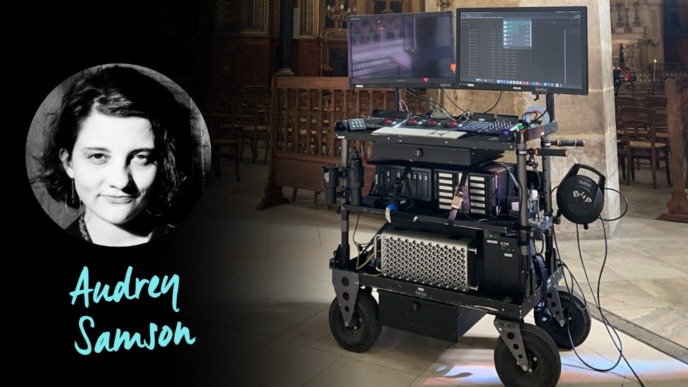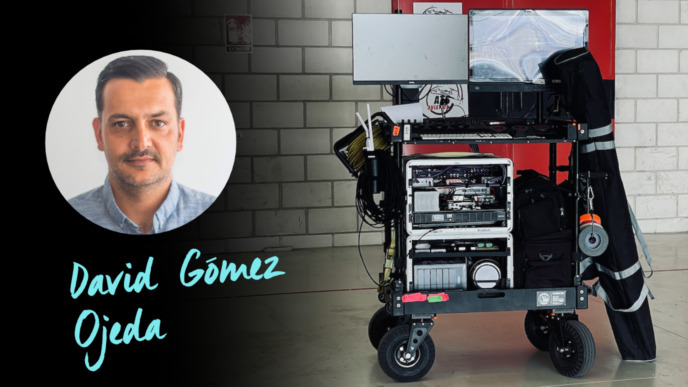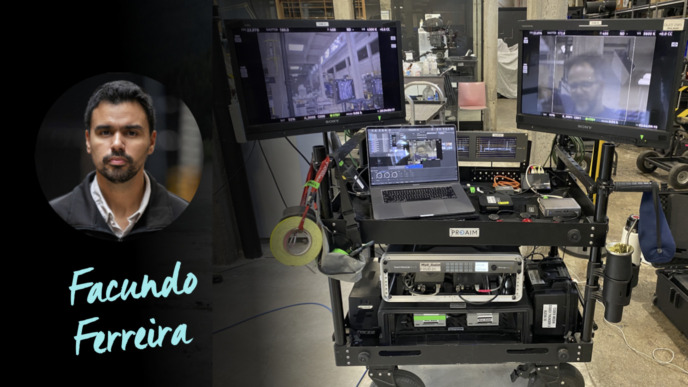
Chris’s field of work as a DIT is strongly rooted in commercials and advertising, as he transitioned from photography to motion. With the ever-altering demands of different jobs in both worlds, he constantly adapts his setup to production and location challenges. Keep reading for a detailed walkthrough and an exciting strategy to push your career forward with pink accessories and a woodpecker’s approach to problem-solving.
First of all, thank you so much for doing this interview with us! To start, could you please tell us a little bit about yourself and your professional life?
Hello! I’m a DIT based in Boston, Massachusetts, and I’ve been freelancing for over 7 years. I have fallen into the film industry after being a still photography-based digital tech. After graduating from the Rochester Institute of Technology, I worked at a few photography industry companies before freelancing as a photo assistant and digital tech. After a few years, there started to be more and more stills shoots with motion components – even if it was just B-roll – and I was being asked to manage the data. So, after some encouragement from a few local union DITs, I’ve been working increasingly with motion for roughly the past three years.
Emerging from still photography, what kind of jobs are you mostly involved in? Can you point out any similarities?
I am a purely commercial and advertising DIT and media manager, so most of my jobs are either more run-and-gun media management jobs where we have multiple locations a day, but I’m taking on more and more situations with calls for interactive color adjustment, signal distribution, and making the signal at video village zing. Coming from a commercial stills workflow, where the camera is almost always tethered into Capture One, the mindset of adjusting color and neutralizing out casts via Livegrade Pro and organizing (and labeling) mags and metadata in Silverstack Lab are extremely similar in concept. Even transcoding (most often in my case for quick client review off-site via ProRes 422 LT proxies, uploaded via whatever service the client prefers) is similar to JPG generation from the stills RAW files.
While the specific programs and hardware differ, it’s a surprisingly similar file management and color pipeline workflow.
We know that every DIT’s setup varies. Overall, how would you describe yours?
The best way to describe my setup: it is ever-changing! Both due to budget, constantly changing job needs, and personal development. I’m always trying to balance offering the ability to do everything whiledealing with production/logistics challenges. Adding in, the need to dual-role my cart for stills and video. It’s a constant tinkering process.
Let’s take a closer look at your setup! Could you walk us through the bits and pieces?
The flexibility needs mentioned above mean that most everything above is run into one of two CalDigit TS3 or TS4 docks, which are connected to the computer needed for the job. On lightweight gigs without transcodes, or an all ProRes setup, I’ll bring my Apple M1 MAX laptop, but I do have an Apple Mac Pro 12 core computer for things that require ARRIRAW, SONY X-OCN, or REDCODE. The docks let me have everything above the top deck remain the same and then simply swap out the brain/computer.

My full-blown DIT setup, as it currently stands, is very much a cart-based setup. I work on an Inovativ Scout 37 EVO, that I’ve added a dual-bar Whaley Rail to the top deck. Generally, as I’m starting out, most of my work has been single cam, so I usually have one of my Flanders Scientific DM240s monitors on the top, with a matched twin out on a rolling Matthews Monitor stand for either my DP or video village. I’ve got a Tangent Wave 2 for my control surfaces, although I’m experimenting with swapping in a Stream Deck + and downsizing to a Ripple. I’ve snagged a 15” GUI monitor from Amazon, and flipped it upside down to mount it under my DM240. Lastly, I’ve got a little 14” 4K stretched monitor mounted vertically next to my Flanders, and I’m running OmniScope for exposure and color monitoring.

On smaller media manager-only jobs, I’m either running just a laptop strapped to an Inovativ Digiplate with my shuttles attached or (ideally) using the Chromatic pictures DIT-box-inspired setup I’m building.
Which Pomfort products do you rely on?
Livegrade Pro and Silverstack Lab are both two programs that help simplify my productions and boost my confidence in ensuring everything goes smoothly. Especially with how Look Archives transfer look data (via .pfla files) between the two, I can help out my AE and editors with far more featured reports from the information I’m generating on the fly from Livegrade Pro. In a smaller commercial market like Boston, where the producer and editor are often much closer than on features, this helps keep the people who hire me happy.
How do you manage the power supply to your DIT cart?
While I’m not DC converted on my gear yet, I am running everything through either a Cyberpower 1500 VA UPS that comes in its own 2U rack or a smaller Schneider APC 850 if I’m on a simple laptop-only job. On location, I often run everything through one of my more favorite pieces of gear: my Ecoflow Delta Max 2000. Not having to wait for a genny to up or worry about pure sine wave vs. dirty power is a big help.
We spotted all the pink details and accessories on your setups. We’re curious: What is it all about?
It’s an extension and continuation of a DIT and digital tech who helped me out early in my career. He saw from an Instagram photo that I had a drink on an early cart right next to my laptop and messaged me that I should get myself a RoboCup drinks holder. I said I’d do it with my next check, and he responded: “They’re $30, I’ll buy you one. I’ll buy you a PINK one!” I replied: “You know, I’d rock the heck out of a pink cupholder.”
2 more cupholders, 150’ of stingers, and countless pink-sheathed SDI cables later, I’ve got a bit of a theme going. The amount of DPs, photographers, and producers who can’t remember my name, are chatting with someone about “that guy with the pink stuff,” and then hire me again once they get told my name. It has definitely helped keep my career going.
What does your unique woodpecker logo stand for?
When coming up with a new brand identity for an umbrella to cover both, my stills and DIT businesses, my designer asked me for an animal that describes my approach to work. After a day, I responded woodpecker. When I identify a problem, I attack it from as many angles as possible until I find a solution, a workflow, or at least a workaround after I’ve drilled down to the core of the issue.
Be it the electric pink accessories, or the woodpecker, I’ve always believed that you need to be several things to grow in this industry. In this order: Be good at what you do. Be efficient at how you do it. And be memorable in a positive way.

How does your setup differ depending on the tasks you are asked to do?
The jobs that require live grading are generally based on my cart, but jobs that are more media management-only are more flexible. If I can park on a table with my laptop, a few Thunderbolt docks, and shuttles, I can safely manage media. I am experimenting with custom-modified Pelican cases and battery solutions to have a setup that is more able to move on the run. But as I like to say, that’s future Chris’s problem…
Personally speaking, what’s your favorite component of your setup?
My favorite pieces lately are my homemade designed and built Stream Deck mounts. I ALWAYS find myself scrambling for more space on the top deck of my cart, so printing cases to safely transport my Stream Decks that can also be mounted to an arm off the deck is huge.
But I always come back to my pink RoboCups, pink stingers, and pink SDI cables. In a sometimes dour, “all blacked out everything” industry, it’s nice to have a pop of a cheerful color.

What has been the latest addition to your setup?
The most recent addition has been the 3D-printed cases I’ve designed for my Stream Decks. I’ve been long trying to make sure I have my gear protected in transport and have the ability to mount them via a NATO rail or ARRI Anti-Twist mount to the cart. That has been a very pleasant workflow addition.
Are there any notable stories that have happened with or to your setup that you’d like to share with us?
I think ending up in a completely blue E-Z UP tent, roughly 6 feet from the side of a busy state highway in ~40-50°F weather, would probably be the most memorable. Situations like that are the ones that make me constantly and ruthlessly strive to streamline and add components, so I’m either better able to have a neutral color, be closer to set, or at least be able to set up somewhere that’s warmer…
Are there any dream projects you are thriving for?
Not a specific project, but I’m looking forward to joining Local 600 in the future as a DIT and working on features. I’ve always been a strong proponent for unionized workforces for my friends and am excited to be able to join IATSE myself.
Anything you would like to add?
I think that’s all! Thank you again for helping this guy who started on the stills side of things grow and satisfy an incredibly wide range of client needs with some killer software.
Big thanks to Chris for giving us a glimpse behind the scenes and sharing his story with us!

Chris Valites, DIT
Chris Valites is a commercial Digital Imaging Technician based in Boston, Massachusetts (USA.) Working as both a stills digital tech and video DIT, he enjoys working on mixed sets and testing out new solutions for a primarily location-based workflow.



